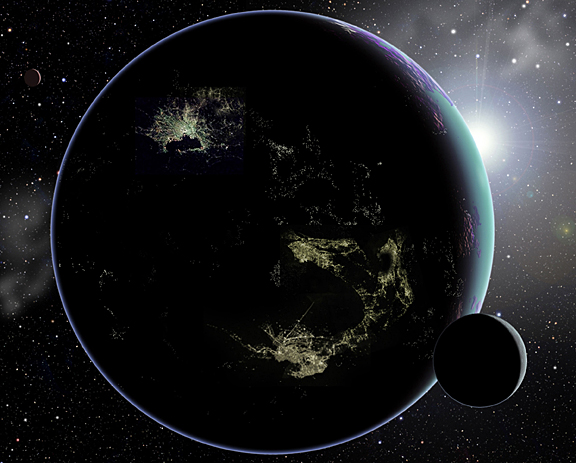 |
| Graphic showing putative extrasolar planet with cities, a moon, and partially eclipsed star |
Inspect extrasolar planets for the lights of alien cities … that’s the way to find ET.
Such a stupid idea we would all be embarrassed to mention it. Unless you're a Harvard scientist that is. In a recent paper, Avi Loeb (Harvard-Smithsonian Center for Astrophysics) and Edwin Turner (Princeton University) suggest a new technique for finding aliens: look for their city lights. "Looking for alien cities would be a long shot, but wouldn't require extra resources. And if we succeed, it would change our perception of our place in the universe," said Loeb.
Hitherto, in the search for extraterrestrial intelligence, astronomers have hunted for radio signals and ultra-short laser pulses.
See City Lights Could Reveal E.T. Civilization (press release, Thursday Nov 3, from Harvard-Smithsonian Center for Astrophysics).
That extrasolar planets can be detected at such distances against the glare of the parent star is stupendous enough, without seeing lights from cities. But the guy’s from Harvard, so we presume he knows what he's talking about.
I ought to add that the graphic shows the view from a hypothetical (and in practice impossible) nearby space probe. No Earth-bound astronomer would see the planet this way, since from here any extra-solar planet always has a much smaller apparent diameter than its parent star, and can never obscure more than a tiny fraction of its light. (Unless the star were a white dwarf but we won’t go into that.)
Nor should we infer from the graphic that astronomers can train their telescopes on an extrasolar planet and spot the city lights in the manner shown. That’s not what is proposed, nor, I guess, would it be possible with any foreseeable technology. Astronomers don’t actually “see” extrasolar planets in this fashion, they “read” them from strings of data, and what's proposed by the two professors is that by analysing the light emitted from a planet, they could distinguish artificial light by its characteritic signature of wavelengths.